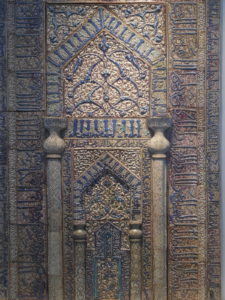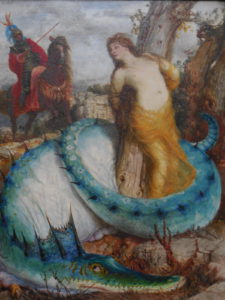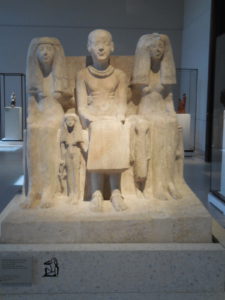Museum Island: Five dazzling museums in Berlin
By Tracy A. Burns
Pergamon Museum
 One of the most visited museums in Germany, this early 20th century exhibition space is home to the Ishtar Gate of Babylon and the Market Gate of Miletus as well as the Aleppo Room. The Ishtar Gate welcomed people to the city of Babylon and dates from approximately 575 BC. The Market ate of Miletus, a monumental work of Roman architecture, hails from 2 AD. Don’t miss the Aleppo Room, a richly decorated red reception room from a broker’s house, built during the Ottoman era. The Pergamon Altar, one of its masterpieces, is closed indefinitely. The museum includes a superb Islamic Art collection, too. The Pergamon Museum was damaged during World War II. After the war, Soviet troops took most of the artifacts back to Russia. Many of the items were returned in 1958, but some important works are still in Russia.
One of the most visited museums in Germany, this early 20th century exhibition space is home to the Ishtar Gate of Babylon and the Market Gate of Miletus as well as the Aleppo Room. The Ishtar Gate welcomed people to the city of Babylon and dates from approximately 575 BC. The Market ate of Miletus, a monumental work of Roman architecture, hails from 2 AD. Don’t miss the Aleppo Room, a richly decorated red reception room from a broker’s house, built during the Ottoman era. The Pergamon Altar, one of its masterpieces, is closed indefinitely. The museum includes a superb Islamic Art collection, too. The Pergamon Museum was damaged during World War II. After the war, Soviet troops took most of the artifacts back to Russia. Many of the items were returned in 1958, but some important works are still in Russia.
Old National Gallery (Die Alte Nationalgalerie)

The building itself is an architectural gem, looking like a temple from classical antiquity. The museum opened in 1876. While it suffered damage during World War II, the Old National Gallery was restored, opening four years after the war. From 1998 to 2001, it underwent its last phase of reconstruction. The collection of 19th-century art is top-rate, showcasing works from the Neoclassical and Romantic periods as well as significant Impressionist paintings. Caspar David Friedrich, Max Liebermann, Claude Monet, and Edouard Manet are a few of the major artists represented. The museum also is home to the largest collection of paintings by Adolph Menzel. The Old National Gallery hosts intriguing temporary exhibitions, too.
Bode Museum
Constructed in the early 20th century, the Bode Museum houses a remarkable collection of sculptures – one of the largest in the world – as well as Byzantine art, coins, and medals. Sculpture in Byzantine, medieval, Italian Gothic and early Renaissance styles will dazzle you. Byzantine art from Ravenna, Italy is especially impressive. Architectural sculpture, glazed terracotta, and small sculptural works from bronze and ivory are sure to amaze. The coin cabinet ranks as one of the
largest in the world with coins hailing from 7 BC to the present day. The museum also boasts interior décor in the Italian Renaissance style.
The Neues Museum
 Originally built in the 19th century, the Neues Museum underwent refurbishing from 2003 and 2009, thanks to British architect David Chipperfield. It retains 19th-century elements while taking on modern characteristics, making it a building of architectural interest. It was recognized by UNESCO in 1999. The museum has three sections – The Egyptian Museum and Papyrus Collection, the Museum of Prehistory and Early History, and the Collection of Classical Antiquities. One
Originally built in the 19th century, the Neues Museum underwent refurbishing from 2003 and 2009, thanks to British architect David Chipperfield. It retains 19th-century elements while taking on modern characteristics, making it a building of architectural interest. It was recognized by UNESCO in 1999. The museum has three sections – The Egyptian Museum and Papyrus Collection, the Museum of Prehistory and Early History, and the Collection of Classical Antiquities. One
highlight is the Bust of Queen Nefertiti. Note the precision – you can even see veins on her neck. The mysterious Berlin Golden Hat, only one of four in existence, hails from the Bronze Age and is decorated with astronomical symbols. The Neanderthal skull from LeMoustier is also on display.
Altes Museum (Old Museum) Constructed from 1823 to 1830 by renowned architect Karl Friedrich Schinkel, this Neoclassical building with a stunning rotunda was designated a UNESCO World
Heritage Site in 1999. The antiquities collection and temporary exhibits are housed here. With exhibits from Ancient Greece dating from the 10th to the first century BC, the museum shows off many intriguing vases, sculptures, and tomb reliefs. The Etruscan art collection is extensive and provides visitors with an insight into Etruscan daily life and language. The Romans are also highlighted with portraits of Caesar and Cleopatra not to be missed.




